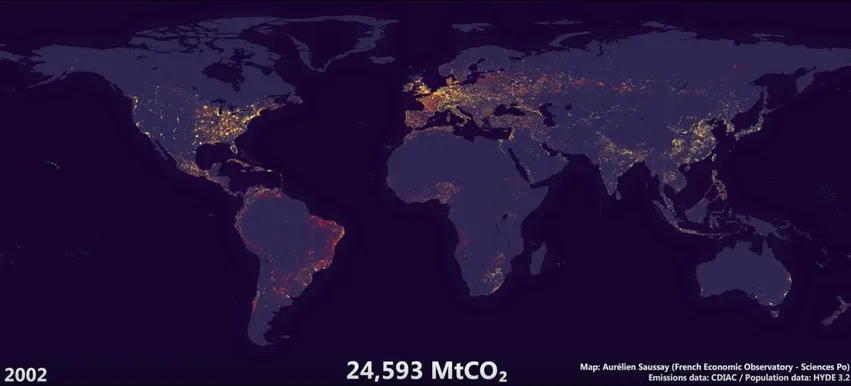Who Releases the Most Greenhouse Gases?
In this free climate resource, learn which countries, populations, industries, and companies are the top greenhouse gas emitters, currently and historically.
Teaching Resources—Climate Change: Policy (including lesson plan with slides)
Higher Education Discussion Guide
Since the Industrial Revolution, rising emissions of greenhouse gases—including carbon dioxide, methane, nitrous oxide, and others—have been the driving force behind climate change.
Who is responsible for emitting the most greenhouse gases? The answer may not be as clear as one might assume, because the top emitters change depending on how the data is collected and what numbers are included.
When looking at emissions by country, there are three ways researchers generally sort their data:
- Annually, the total greenhouse gases emitted every year.
- Cumulatively, the historical levels of emissions by a country.
- Per capita, the average greenhouse gases emitted by each person.
Annually: Which countries emit the most greenhouse gases every year?
One way to understand responsibility for greenhouse gas emissions is to examine which countries emit the most every year.
Two of the top countries on this list, China and India, are experiencing rapid economic growth. Also on the list are the United States and European Union members—developed countries that have historically emitted and continue to emit greenhouse gases at high levels.
It is important to note that these ten countries produce a majority of global emissions. In 2017, they accounted for more than two-thirds of global greenhouse gas emissions. And the one hundred countries that emit the least? They collectively produced less than 3 percent of the world’s greenhouse gas emissions that year.
Looking at the top ten fossil fuel–producing countries can help policymakers focus climate change legislation to address emissions. While the annual data tells the story of which relatively small number of countries is responsible for current emissions, it does not account for countries that previously released large amounts of greenhouse gases but have since been able to afford cleaner energy sources. To account for this fact, researchers take a cumulative, or historical, approach to the data to determine the top emitters.
Cumulatively: Which countries have historically emitted the most greenhouse gases?
Calculating emissions data cumulatively allows a researcher to understand which countries have historically emitted the most greenhouse gases.
This way of looking at emissions illustrates the uneven history of industrialization: about half of total carbon dioxide emissions have been released by a handful of now-developed countries. Industrialization massively increased standards of living in countries that developed early—and hugely increased their emissions, which have only compounded with time.
Meanwhile, countries that developed later are further down on the historical list of emitters: for example, although China tops the list of annual emitters as it fuels its rapid development today, its carbon dioxide emissions account for only 13 percent of the historical total. (Carbon dioxide is the largest contributor to climate change, so sometimes it is measured independently of other greenhouse gases.)
Per Capita: Which countries emit the most greenhouse gases by population?
Unlike the other lists, which are dominated by large countries with developed or rapidly growing economies, at the top of this list are small countries that rely on energy-intensive industries.
The energy-intensive industries causing emissions often vary depending on each country’s economic climate. For example, Guyana and Paraguay are clearing lots of forestland to make way for new industries, so deforestation contributes to climate change there. In Mongolia, the use of fossil fuels and the clearing of grasslands for agriculture contribute to the country’s high emissions profile.
Examining emissions per capita also exposes differences among top annual greenhouse gas emitters. For example, the United States’ per capita emissions are more than eight times those of India. Although the United States and India rank high in terms of annual emissions, India and neighboring China both have much lower per capita emissions given their large populations (each exceeding one billion).
Economic Sector: Which industries emit the most greenhouse gases?
As we have seen, a country’s greenhouse gas emissions are often tied to its level of industrialization. So it is also helpful to look at what kinds of industries produce the most greenhouse gases.
Each industry contributes to emissions in various ways:
- Energy sector generates the most greenhouse gas emissions. Emissions related to energy are tied to various sources including electricity and heat that power households, manufacturing, construction, and transportation.
- Industrial processes unrelated to energy generation also cause emissions. For example, greenhouse gases are emitted during the production of materials like cement and glass, as well as household goods like soap and detergent. Additionally, the industrial process of extracting fossil fuels such as oil or natural gas generates emissions.
- Agricultural sources, such as farming, including manure management, fertilizers, field burning, and fuel use on farms, generate emissions. In fact, about one-third of agricultural emissions come from animals belching: when a cow burps, it releases methane gas—and cows burp a lot.
- Land-use change and forestry include activities such as deforestation. Deforestation contributes to increased emissions in two ways. The machines that cut down and process trees use fossil fuel, which generates emissions. And since trees use carbon dioxide during photosynthesis, cutting them down reduces the earth’s ability to soak up the increased carbon emissions.
- Waste elimination processes such as incineration and landfilling emit greenhouse gases. For example, as organic material in landfills disintegrates, it produces methane.
- Bunker fuels power ships and aircraft. The term refers to the thick, viscous oil left over after crude oil goes through the refining process of extracting diesel and gasoline. Only large, complex engines like those in ships can heat up bunker fuel enough for it to combust.
Companies: Which companies are the top emitters of greenhouse gases?
Now that we have looked at which countries and sectors emit the most greenhouse gases, there is another way to look at emissions that combines the two. We can look at how companies—both private and government-owned—contribute to climate change.
It is important to note that this chart examines
- emissions caused by a company’s operations, and
- emissions from products or services provided by that company.
The amount of emissions of any oil company shown on the chart is the combination of both the greenhouse gases released during the process of extracting the oil from the ground and the burning of all that oil by customers who use it to power their cars or to generate electricity, for instance.
Due to the high levels of emissions in both their operations and the consumption of their product, fossil fuel companies are the top emitters. According to one report, between 1751 and 2017 just 103 companies have released more than two-thirds of industrial greenhouse gas emissions—the top ten of which are fossil fuel companies.
Why is it important to know the top greenhouse gas emitters?
Since climate change greatly affects every issue we face today, understanding the effect of greenhouse gas emissions on our economies and our environment is crucial. Understanding which countries, industries, and companies are the top greenhouse gas emitters can help policymakers decide where to focus their attention as they tackle issues such as global trade, job growth, energy independence, environmental safety regulations, and more.
This knowledge also raises questions: Should those responsible for emitting the most greenhouse gases also be most responsible for mitigating and reversing the effects of climate change? And if so, what metric should be used to determine who these top emitters are?









